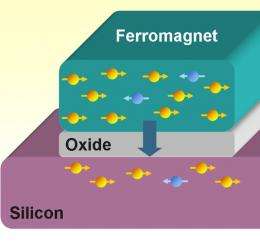November 27, 2009 weblog
Spin polarization achieved in room temperature silicon

(PhysOrg.com) -- A group in The Netherlands has achieved a first: injection of spin-polarized electrons in silicon at room temperature. This has previously been observed only at extremely low temperatures, and the achievement brings spintronic devices using silicon as a semiconductor a step closer.
Spintronics, or spin electronics, is an emerging field of electronics that aims to be able to represent digital information by using the spin of electrons as well as their charge. When fully developed, spintronic devices could profoundly change data storage devices, computer architecture and so on, and they could reduce energy use to ultra-low levels.
Electrons are basically a two-state system with their spins either "up" or "down". For a spintronics device to work, it must have a system (the spin injector) that produces a spin-polarized electric current, which has more of its electrons in one spin state than the other. It also needs a spin detector that can detect whether the electrons are up or down.
In metallic systems spin polarization is generally achieved by passing an electric current through a ferromagnet. (It is magnetic because the electrons within it are polarized, and as they pass from the magnet to the metal they remain polarized for a short time.) Spin polarization has also been achieved at room temperature in ferromagnetic semiconductors such as manganese-doped gallium arsenide.
Until recently spin polarization in non-magnetic semiconductors like silicon has only been achieved at temperatures of 150 K, but new research has achieved spin polarization at ambient temperature. Scientists Saroj P. Dash and colleagues at the MESA Institute for Nanotechnology at the University of Twente in The Netherlands used a single nickel-iron electrode on top of silicon, with a layer of aluminum oxide between them. When they applied a current to the electrode they observed a "puddle" of electrons in the silicon, which could then be dissipated by applying a magnetic field. This caused an observable voltage drop across the contact.
As a control they inserted a layer of ytterbium between the electrode and the aluminum oxide, since ytterbium is known to destroy spin polarization. When the current and magnetic field were applied, no voltage drop was observed, which indicates that spin polarized electrons had caused the effect.
Spintronics could eventually lead to extremely low energy use devices, and perhaps ultimately to quantum computers. More research is needed to prove the spin-polarized currents really flow through the silicon, and it may still be several years before the promised ultra-low power devices are developed.
The research was published yesterday in the journal, Nature.
More information: Electrical creation of spin polarization in silicon at room temperature, Nature 462, 491-494 (26 November 2009), doi:10.1038/nature08570
© 2009 PhysOrg.com


















